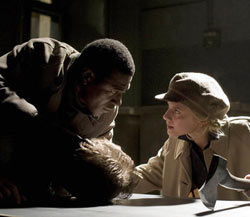As the Emmy awards approach while the Fall season kicks into gear, AMC’s “Mad Men” is at the top of both discussions. It garnered 16 Emmy nominations,
more than “Desperate Houswives,” “Grey’s Anatomy” and “ER” combined. And for good reason.
“Mad Men” has managed to re-create not only the fascinating business environment of 1960, the pivotal nature of that decade’s history, the zealous (sometimes fanatical!) world of Madison Avenue advertising and the loquacious nature of men among each other paired with their relative ambivalence at home.
Further, it also gently dives into the curious and oft-overlooked nature of religion and spirituality that reigned in that tumultuous time. On a show where chauvinism, womanizing and fraternizing is one of the main characters, Elisabeth Moss’s “Peggy” explores fairness issues for women, her family’s Catholic faith and her apparent departure from it, her attempt to be included in the debauchery-laden pecking order of her business, the aggressive proselytizing of a Catholic father, her own family’s fixation with her church attendance and the Priest’s fixation on her prior sins.
And it hasn’t gone without notice. Ms. Moss (formerly a “West Wing” first daughter) is up for a “Best Actress” Emmy award, given a profile on the show even larger than the main character’s wife or mistresses. “Jon Hamm might be the face of ‘Mad Men,'” wrote Rachel Kolb of thecelebritycafe.com, “but Elisabeth Moss has become the show’s heart.”
The cast of characters represents all that was accepted then–but would be appalling now–as to how women were treated. Married husbands Don Draper, Roger Sterling and Peter Campbell have all been unfaithful to their wives s so far, and the show’s only just started in Season Three! An office manager was essentially date raped by her fiancé. The show’s first lady considers an abortion and engages in behavior that could help it happen naturally. Men essentially anesthetize themselves from life’s deeper things through alcohol and smoking. No, this doesn’t look like your typical religious show.
But for the countless people who have known for decades that the “Leave it to Beaver” life was the exception–not the rule–of family life in the 50’s and 60’s, this show can have a cathartic effect for those who seek to understand why our parents were, well, the way they were. They may not have been in advertising–or even in New York for that matter–but they came from that era, an era where the one person who seems to authentically pursue matters of faith, justice and practice stands out like a sore thumb to her peers and a breath of fresh air to a spiritually minded viewer.
Final thought: there was one scene where the priest was dining with four ladies in their home. Upon being asked to bless the meal, he prayed an honest prayer from his heart. When done, the matriarch affirmed the “nice thought” and then asked, “are you going to say the blessing now?” He then stood and gave the standard Catholic meal prayer. Were there others like him, in real life, even back then, who were honestly reflecting on the direction of religion’s faith and practice? You bet, and I’m glad the Father Gill character is in the show.



